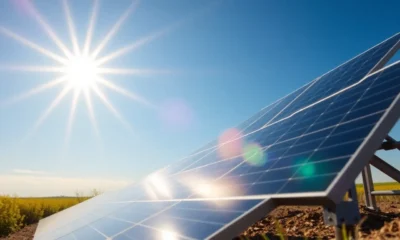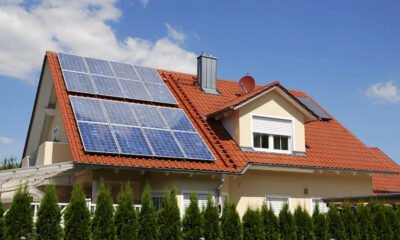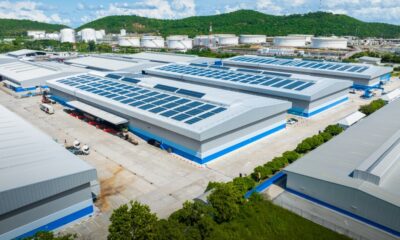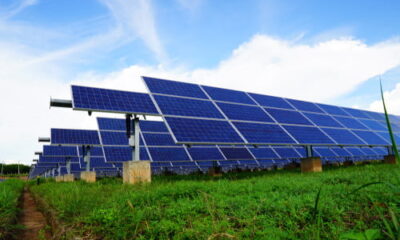Features
Profit from Solar
Will Vooght investigates the financial opportunities in small-scale solar power.
Following the introduction of the Feed-in Tariff in April 2010, many people took the view that putting your money on your roof in the form of solar PV panels could be a wiser alternative than sticking it in the bank.
Will Vooght investigates the financial opportunities in small-scale solar power.
Following the introduction of the Feed-in Tariff in April 2010, many people took the view that putting your money on your roof in the form of solar PV panels could be a wiser alternative than sticking it in the bank.
PV isn’t cheap – which is why payment for small solar generators has been set high. This puts it on a level playing field with other generation technologies and encourages investment. But not everyone’s got £10,000 or more to invest in their own renewable generator, so several schemes have recently sprung up offering individuals the chance to ‘rent out their roof’ to a PV installer. The householder benefits from free electricity while the installer collects the FiT payments – a concept known as ‘PV for Free.’
So, are you better off paying to install your own system, or taking advantage of a PV-for-Free scheme?
Investing in your own generator
If you’ve got the cash and are planning on staying in your property for a while, investing in your own generator is not only sound environmental practice – it’s a good economic one too. For a modest-sized, well-positioned system (say, 2.5 kilowatt peak, costing around £12,000) you could expect a return of around £1,000 a year. Taking into account the money you’d also save on your electricity bill, your investment should pay for itself in around 10 years. And payments are not only index-linked, but also guaranteed for 25 years, so you’ll be in profit for another 15 – more than doubling the return on your initial outlay.
If you haven’t got cash to invest up front, accessing a decent loan might be the next best option. If you borrow at a typical rate of 8 percent, your PV should have covered its costs over 15 or 16 years. That gives you around 10 years of interest-free earnings.
PV for Free
 PV for Free However, if you don’t want to invest your own money or accept the risks of borrowing, PV for Free can be an attractive option. In return for ‘renting’ your roof, you can claim the FiT and exported energy payments, but all the electricity you generate and use from the panels is free. This could save around £140–£150 a year on your bills; more if you’re able to increase your electricity usage during the daytime, when the panels generate most, and reduce it at night.
PV for Free However, if you don’t want to invest your own money or accept the risks of borrowing, PV for Free can be an attractive option. In return for ‘renting’ your roof, you can claim the FiT and exported energy payments, but all the electricity you generate and use from the panels is free. This could save around £140–£150 a year on your bills; more if you’re able to increase your electricity usage during the daytime, when the panels generate most, and reduce it at night.
While the quantitative arguments appear to favour installing your own system, there are qualitative reasons for choosing PV for Free. For example, installing and maintaining the system is someone else’s responsibility and it’s in their best interests to make sure it’s working optimally. Some companies also give you the option to buy the system from them once they’ve installed it, so you can ‘try before you buy’.
The Government recently announced an early review of the Feed-in-Tariff, sparked by the popularity of large-scale solar schemes, such as solar farms. However, it’s expected to target schemes above 50kW, so domestic-scale PV systems should continue to receive a similar level of FiT payment as they do now.
Solar hot water
 Solar Hot Water Another option to consider is investing in solar thermal technology, which uses the sun’s power to heat water. These systems require a lower initial investment than solar PV, typically around £4,000, and can help you make considerable savings on your hot water heating costs, particularly during the summer months. There are plans afoot to reward solar thermal generators too. The Government sees renewable heat as a priority area for growth and is expected to announce shortly the details of a renewable heat incentive (RHI), aimed at being operational from June 2011. In a scheme similar to FiT, the RHI will make payments calculated on the annual amount of renewable heat produced per year, with tariff levels dependent on the technology chosen.
Solar Hot Water Another option to consider is investing in solar thermal technology, which uses the sun’s power to heat water. These systems require a lower initial investment than solar PV, typically around £4,000, and can help you make considerable savings on your hot water heating costs, particularly during the summer months. There are plans afoot to reward solar thermal generators too. The Government sees renewable heat as a priority area for growth and is expected to announce shortly the details of a renewable heat incentive (RHI), aimed at being operational from June 2011. In a scheme similar to FiT, the RHI will make payments calculated on the annual amount of renewable heat produced per year, with tariff levels dependent on the technology chosen.
RHI is not a new idea, though. Good Energy’s own version of a renewable heat incentive, financed by customers on its Gas+ tariff, is called HotROCs and has been running since September 2008.
If you’re a homeowner interested in generating your own solar power, it can only be a good thing that so many technologies are available. However, do make sure you fully understand your options so you can determine the right choice for you.
To find out more, visit www.generateyourown.co.uk


 Environment10 months ago
Environment10 months agoAre Polymer Banknotes: an Eco-Friendly Trend or a Groundswell?

 Environment11 months ago
Environment11 months agoEco-Friendly Home Improvements: Top 7 Upgrades for 2025

 Features9 months ago
Features9 months agoEco-Friendly Cryptocurrencies: Sustainable Investment Choices

 Features10 months ago
Features10 months agoEco-Friendly Crypto Traders Must Find the Right Exchange





























